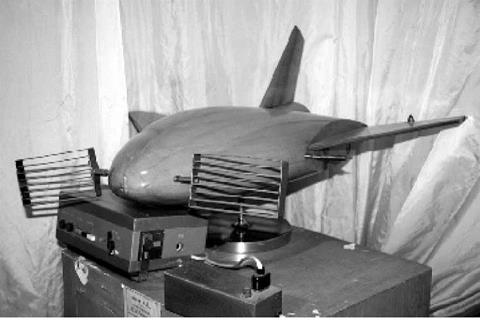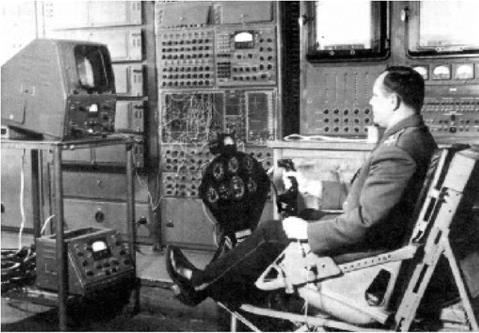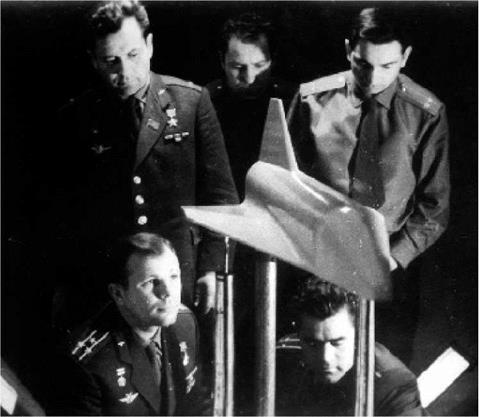SPACEPLANE STUDIES AT THE ZHUKOVSKIY ACADEMY
Winged spacecraft were not only studied at spacecraft and aviation design bureaus, they were also the subject of academic studies by the original Air Force cosmonauts during the 1960s. In September 1961 most of the cosmonauts of the original “Gagarin group’’ began studying at the prestigious Zhukovskiy Academy in Moscow to improve their engineering skills in preparation for future space missions. In 1964 they were joined by the five women who had been selected for cosmonaut training in 1962. The culmination of the studies would be a thesis in a chosen field of specialization that the candidates would defend before their tutors in written and oral sessions at the end of their course.
Rather than pick a completely different subject for each candidate, it was decided that all would work on one general theme. In 1965 Sergey Korolyov recommended that the cosmonauts should study a practical design for a winged reusable spacecraft, a suggestion that was accepted by the cosmonauts’ supervisor Professor Sergey Belotserkovskiy. Fifteen cosmonauts were involved in the thesis work: Yuriy Gagarin, Gherman Titov, Andrian Nikolayev, Pavel Popovich, Valeriy Bykovskiy, Aleksey Leonov, Boris Volynov, Yevgeniy Khrunov, Georgiy Shonin, Viktor Gorbatko, Dmitriy Zaikin, Valentina Tereshkova, Irina Solovyova, Tatyana Kuznetsova, and Zhanna Yorkina. Each of them was given the liberty of choosing from a series of topics suggested by their tutors. Gagarin, for instance, decided to focus on aerodynamics during approach and landing, Nikolayev on aerodynamics at hypersonic and supersonic speeds as well as on thermal protection, Titov on emergency escape systems, Popovich on engine design, Khrunov on orientation systems, Bykovskiy on fuel supply, etc.
By mid-1966 the cosmonauts had picked a lifting body shape somewhat reminiscent of the M2F1 “flying bathtub’’ that NASA had been testing at Edwards Air Force Base since 1963. The vehicle would have small wings that would only be
|
Lifting body studied at the Zhukovskiy Academy (source: www. buran. ru). |
|
Gagarin practicing landings in a simulator. |
|
Gagarin and fellow cosmonauts examining an unidentified spaceplane model. |
unfolded for the final approach and landing. In order to improve stability at supersonic speeds, the cosmonauts decided to add small lattice wings to the nose section similar to the ones used in the emergency escape system of the Soyuz launch vehicle.
Part of the work was to test wooden scale models of the spaceplane in wind tunnels and also to practice landings on a crude simulator using primitive analog computers. The tutors followed the cosmonauts’ work with due scrutiny and their critical remarks were not always easily accepted by national heroes like Gagarin. In the autumn of 1967 Gagarin’s thesis failed to pass a critical review because the vehicle had poor gliding characteristics during the final phase of the flight. Gagarin’s solution to the problem, namely to land the spaceplane by parachute, was deemed unacceptable. It took Gagarin several more weeks of theoretical and simulator work to refine the design such that the ship could make an unpowered runway landing.
Most of the cosmonauts defended their thesis projects in January 1968. Gagarin’s turn came on 17 February 1968, only weeks before he died in a plane crash. All of them graduated from the Academy with the diploma of “Pilot-Engineer – Cosmonaut”. Only Gorbatko’s thesis got the result “good” rather than “excellent”.
As it turned out later, this was not because his thesis was worse than the others’, but simply because it was felt not all of them should have the same result. Gorbatko, as one of the unflown cosmonauts at the time, had the misfortune of being picked as the “victim” [30].
The cosmonauts’ spaceplane studies were considered top secret, as was all diploma work at the Zhukovskiy Academy for that matter. Professor Belotserkov – skiy was not even allowed to take snapshots of his pupils, but used a hidden camera nevertheless to record their activities [31]. After having been safely hidden in a safe for almost twenty years, many of them were eventually published in 1986 in a book called “Gagarin’s Thesis’’ [32]. However, even that provided little solid information on the diploma work and did not contain a single proper picture of the spaceplane. This had to wait until another publication by Belotserkovskiy in 1992, where the spaceplane was nicknamed “Buran-68’’ [33]. There is also a famous picture released in the 1970s showing Gagarin and several other cosmonauts examining a model of a delta-wing spaceplane, but that is not “Buran-68”. Belotserkovskiy claims it is Dyna-Soar, but it clearly is not that either. Some have questioned the authenticity of the picture, but the model in question has recently been seen at the Zhukovskiy Academy.
Research on the diploma project coincided with early work on the Spiral system, but as yet there is no evidence of any interaction between Mikoyan’s team in Dubna and the Air Force cosmonauts, although Titov began training for the Spiral program in 1966-1967 and must have been aware of the project’s details. Although the finished thesis projects were sent to Lozino-Lozinkiy’s team, there are no indications that they in any way influenced the design of Spiral or future spaceplanes [34].













